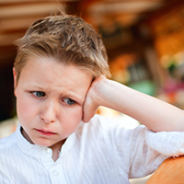
Children and teens with bipolar disorder experience unusual and extreme mood changes, which can affect energy and behavior.
Bipolar disorder in children is possible. It’s most often diagnosed in older children and teenagers, but bipolar disorder can happen in children of any age. As in adults, bipolar disorder in children can cause moodiness from the highs of hyperactivity or euphoria (mania) towards the lows of serious depression. These changes are different from normal childhood and adolescent ups and downs. Sometimes, those with bipolar disorder feel very happy and therefore are much more active than usual. But other times, they think extremely sad and are much less active.
As a parent of a child or young person with bipolar it can be very difficult to understand and are available to terms with the condition, the causes, treatments, available support and also at the same time cope with the impact that it could be having on your family. This leaflet is perfect for parents and carers of young people and children with bipolar, it focuses on the very specific needs of children and young people with bipolar.
What Are the Signs and Symptoms?
Bipolar disorder starts with either manic or depressive symptoms. Symptoms may appear gradually or suddenly, which can make the illness difficult to identify. And they can impair daily life, making it hard to do well in school or get together with friends and family members. Bipolar disorder can also be dangerous because some young people consider suicide.
Depressive symptoms include:
- Loss of enjoyment in favorite activities
- Low energy level, fatigue, poor concentration, complaints of boredom
- Irritability, depressed mood, persistent sadness, frequent crying
- Thoughts of death or suicide
- Frequent complaints of physical illnesses such as headaches or stomach aches
- Major alternation in eating or sleeping patterns, such as oversleeping or overeating
Manic symptoms include:
- Increase in talking – the adolescent talks too much, too quickly, changes topics too quickly, and cannot be interrupted
- Severe changes in mood-either unusually happy or silly, or very irritable, angry, agitated or aggressive
- Great increase in energy and also the ability to go with little or no sleep for days without feeling tired
- Distractibility – the teen’s attention moves constantly in one thing to the next
- Unrealistic highs in self-esteem – for instance, a teenager who feels all powerful or like a superhero with special powers
- Repeated high risk-taking behavior; such as, abusing alcohol and drugs, reckless driving, or sexual promiscuity
What are the causes of bipolar disorder?
Genetics
Some small twin research has indicated that there is a “substantial genetic contribution” to bipolar disorder risk. People with a blood relative who has bipolar disorder have a higher risk of developing it themselves. Currently, scientists are attempting to identify which genes are participating.
Neurotransmitters
An imbalance in naturally occurring brain chemicals called neurotransmitters appears to play a significant role in bipolar disorder and other mood disorders.
Biological Traits
Professionals state that patients with bipolar disorder often have physical changes that took place their brains. Nobody is sure why the changes can result in the disorder.

Bipolar Disorder in Children
Inherited Traits
Bipolar disorder is more common in people who’ve a blood relative (such as a sibling or parent) using the condition. Researchers are trying to find genes which may be involved in causing bipolar disorder.
Brain-Chemical Imbalance
Neurotransmitter imbalances play a key role in lots of mood disorders, including bipolar disorder, as well as depression and other mental illnesses. Neurotransmitters are chemicals that facilitate the communication between neurons (brain cells). Examples of neurotransmitters are serotonin, norepinephrine, and dopamine.
